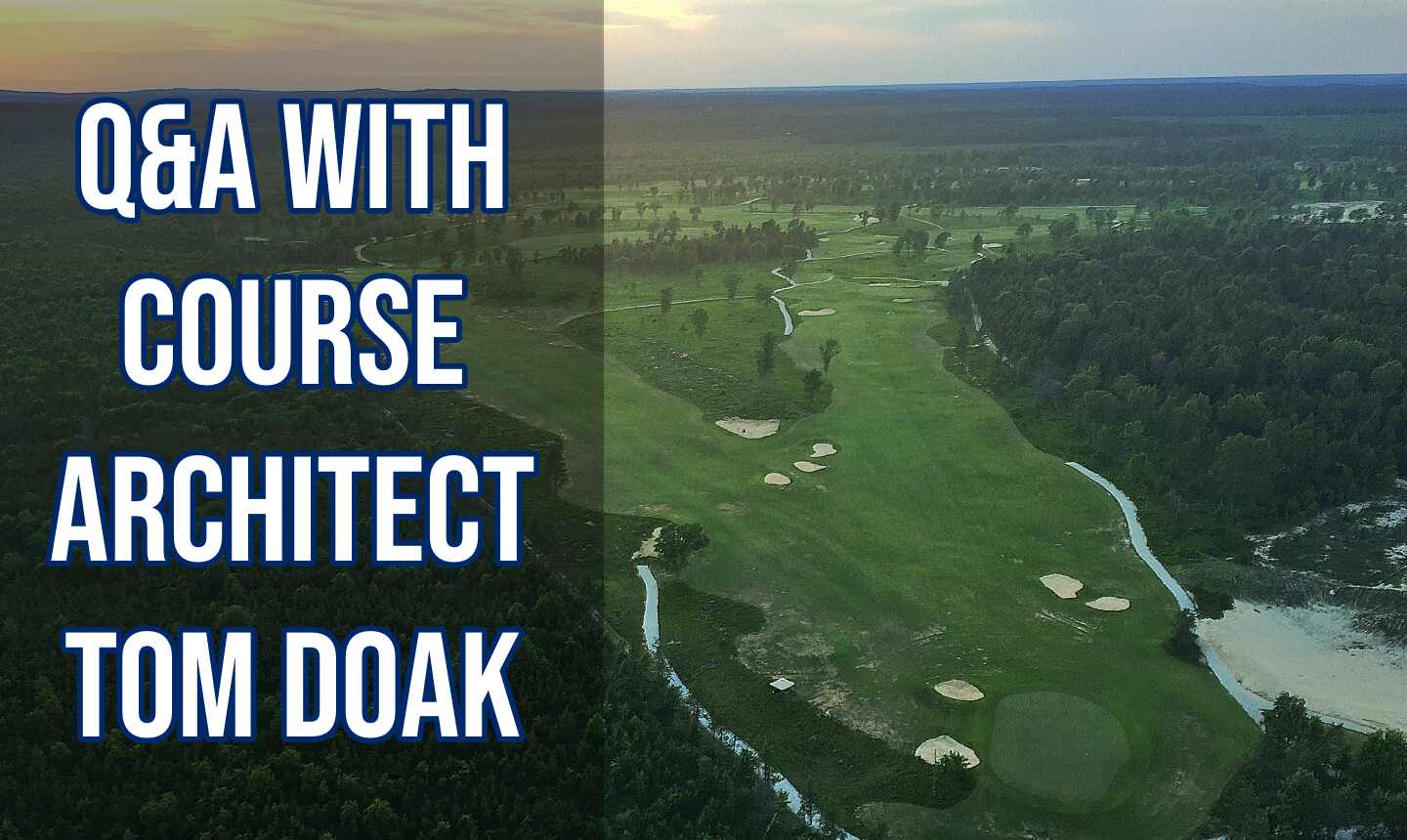 Q & A with golf course architect Tom Doak
Q & A with golf course architect Tom Doak
Posted by
Posted on
 Q & A with golf course architect Tom Doak
Q & A with golf course architect Tom Doak
Ever wonder what goes into designing golf courses? We sat down with Tom Doak to find out!
This Q&A was originally conducted in 2018.
We had the opportunity to chat with today’s preeminent golf architect, Tom Doak. We asked him about golf course design and architecture and to give us insights into his world.
Q: Tom, you just finished a novel concept with a reversible golf course. What was the inspiration for The Loop?
Tom Doak: It's an old idea to play a course backwards, actually. They used to do it on some of the Scottish links 100+ years ago to spread out the wear and tear [if you're playing backwards, you take divots in a different part of the fairway]. One of the old Golden Age architects, Tom Simpson, used to make his holes reversible when he built a course on someone's private estate, so they wouldn't get bored playing the same three holes over and over again. I just thought it was a cool idea, but it took a long time to find the right site, and a client who was willing to take the chance.
Q: What were the challenges designing a reversible course?
Reversible Course Forest Dunes The Loop (MI)
Tom Doak: The two main challenges are visibility and playability. When planning a course in one direction, it's pretty easy to avoid having a hole play up and over a ridge and giving the player a blind shot, but when they're playing both ways, it's harder. It's also harder to see the bunkers. Everything we do to make a bunker more visible from one direction makes it less visible from the other way. Therefore, we had to find a relatively gentle piece of land where that wouldn't be a factor. Most importantly, we had to build greens that would accept shots from two different angles. There are a lot of types of greens that work well for that, but some that don't. Since I'd been thinking about the concept for quite a while, I kind of knew what to avoid.
Q: How do you feel golfers are reacting to The Loop?
Tom Doak: The feedback so far has been really positive. The thing I hear most often is that they can't believe how different the course is when they play the other way around. They're hitting into the same greens, but the background is different and the ground in front of the green is different, so they don't even recognize the green they played to the day before. Some people are compelled to go out a third day to try and figure it out, and that's music to our client's ears.
Q: Will there be more reversible courses?
Tom Doak: As I said, there are a lot of sites where the concept won't work very well. For example, if you took the other course at Forest Dunes and tried to reverse it, you couldn't, because you'd have to hit over the roads in the development that are between one green and the next tee. But on the right site, it's a great idea, especially to give a nine-hole course more variety. The best thing about it, from a business perspective, is if everyone is interested enough to play it both ways, you only have to find half as many customers to keep it full.
Q: How did you get your start in golf architecture?
Tom Doak: A lot of guys were born into the business, but I wasn't. I got interested in the subject when I was 11 or 12 years old, because I got to see a few really good courses on family vacations, and it fascinated me because of how different they were. I had no idea how to pursue golf design as a career. When I was a freshman in college, I started writing letters to people in the golf business asking for advice on what to do, and I got a great amount of support, because none of them had ever gotten a letter like that before. Most importantly, I kept writing letters to Pete Dye, asking if I could work on one of their projects, and after my junior year of college, I got my feet wet on a construction project for the first time at Long Cove Club in Hilton Head.
Q: Tell us about some of your first designs.
Tom Doak: After college, I spent a year in Britain and Ireland traveling to study all the great courses over there, and then I came back and worked for Mr. Dye and his sons for 3-4 years. When I was 26, I stumbled into the chance to build my first course on my own -- High Pointe, just outside Traverse City, Michigan. I moved up there and spent two summers building the course, shaping all of the greens myself on a bulldozer to keep the costs down. That led to another project in Michigan -- Black Forest -- and to the first of the three courses at The Legends in Myrtle Beach, which was based on all the courses I'd seen in Scotland and Ireland. My first private club commission was Stonewall, on an old dairy farm outside of Philadelphia which hosted the USGA Mid-Amateur last year.
Except for The Legends, all of those projects were on interesting pieces of ground and the client didn't have lots of money to throw at building them. Therefore, I modeled my work after all the older courses I'd seen where they only built greens and bunkers and let the lay of the land dictate the shape of the fairway. And that was such a different approach to all the modern designs that my work started to attract some attention.
Q: What architects most influenced you?

Bandon Dunes Golf Resort Pacific Dunes Course (OR)
Tom Doak: I learned everything I know about how to build courses from Mr. Dye. But, I learned about design from seeing all of the best courses in the world and trying to figure out for myself what made them tick. I've borrowed ideas from all of the architects who came before me. The one whose work I was most drawn to was Alister MacKenzie, one of the few who didn't make his reputation in golf as a player. He was less focused on defending par and more on building courses that were interesting and fun to play and fit into the natural landscape. As a 6- or 8- handicap, I could relate better to that approach.
Q: Is there a difference between a minimalist and a traditionalist?
Tom Doak: They're different, but not mutually exclusive. Being a minimalist just means you're happy to work with what the land gives you instead of changing it around to make your holes play a certain way or call for a certain shot. As for being a traditionalist, I guess people have a lot of interpretations of what that means too. That year, I spent in Britain & Ireland had a huge impact on my idea of what golf was and how it fit into people's lives. Over there, golf is a good brisk walk across open countryside, outdoor exercise and interaction with the natural landscape. Golf in America often fails to live up to that ideal.
Q: Do you feel that courses built today are trying to be monuments instead of playable golf courses?
Tom Doak: For me, playability is crucial to having a course that people want to come back and play again. A lot of architects are great players, and they get all caught up in creating a challenge for the guys they are used to playing with, and forget that the average golfer is a 15- or 20- handicap who is out there to have a good time.
Q: What are the crucial factors in creating a golf course?
Tom Doak: Playability is paramount. The most important component of that is finding a routing for the holes that explores the property well, without forcing the golfer to make too many perilous leaps from one shot to the next.
Q: How do you keep coming up with such awesome sites?
Tom Doak: A lot of our clients are people who love golf, and have been successful in their lives, and they want to create a course that's really special. Some of that is about the guy who designs the course, but a lot of it is about the piece of ground you start with. If you invest the time and money to get the right piece of ground, you don't want to hire an architect who's used to shoving dirt around trying to make a housing-development course work, you want someone who's got the reputation for taking a beautiful piece of land and getting the most out of it. Ever since Pacific Dunes, that's been my reputation.
Q: Pacific Dunes is ranked in the top 25 courses in the world. How would you describe it?
Tom Doak: First and foremost, there are four holes that play right along the clifftops overlooking the Pacific Ocean, the only course in America that has more than that is Pebble Beach so that's a pretty good start. But then, as you work inland, the rest of the course is built through sand dunes full of beautiful contour, big natural blowout bunkers, and a mix of pines and flowering shrubs at the margins. It's the fact that the inland holes are just as beautiful as those on the ocean that makes Pacific Dunes stand apart.
Q: How did Cape Kidnappers come about?
Tom Doak: Actually, the developer is an American, Julian Robertson, and he and his son went to play golf at Bandon Dunes the day after Pacific Dunes opened. They wanted to play the other course twice, that's what they were there to do, but the head pro, Tim Hval, prevailed upon them to try the new course too. Not long after that, Julian called to see if I'd be interested in building a course on his property in New Zealand. The cliffs there are much higher. You're 400+ feet above the ocean, looking out over the sweep of Hawkes Bay, so that even the waves in the ocean look like ripples on a pond after you've tossed a rock in.
Q: What about the 15th and 16th holes at Cape Kidnappers?
Tom Doak: The fifteenth and sixteenth sort of evolved during construction. On my first routing, I didn't have a hole on that ground at all because the 15th fairway was so narrow and if you miss it, your ball is gone. Julian encouraged us to use it and said he didn't care if people complained about losing a ball there. The 16th was originally going to be a short par-4, with the tee right where #15 green is now. We were looking to make the course a bit longer and I latched onto today's tee as a potential back tee for #16 that would make it 100 yards longer. But, when Julian and his wife came back to see how things were going, Mrs. Robertson thought that was the most beautiful spot on the golf course and asked if we couldn't make the hole so everyone could play from back there. That’s how #16 became a short par-5 and because we didn't need the original tee, we could move the green on #15 right back to the edge of the cliff, too.
Q: You worked on a project with Jack Nicklaus. What was that like?
Tom Doak: Jack was one of my heroes growing up and I never imagined I'd work with him on a course. He's not really "the competition" because our work tends to appeal to different sorts of clients. But our client for Sebonack, Michael Pascucci, had a special piece of ground right on Peconic Bay in the Hamptons, and he wanted a course as pretty as Pacific Dunes, and as challenging as Jack's best, so he asked us to work together. We agreed from the outset that we wouldn't finish a hole until we were both happy with it and that was unusual for both of us because we're used to making the final decisions ourselves. Jack was very gracious about it and he understood that Michael wasn't paying me just to defer to Jack all the time. The only hard part about it was having to think about what Jack or Michael would think of the green we were building, instead of just having confidence in our own eyes.
Q: You've written several books including your Confidential Guide to Golf Courses, which reviewed more than 900 courses around the world. Not including your own designs, which courses do you consider to be the best?
Tom Doak: I'm actually in the middle of updating The Confidential Guide, after it spent many years out of print. It had become a bit of a collector's item, and of course I've seen a lot more courses over the years. I'm up over 1500 on my own and I've enlisted three co-authors whose opinions I respect so this time we are reviewing more than 2500 courses in all. You can order the books from my website, www.renaissancegolf.com.
There are fourteen courses which I've rated a perfect 10 on the Doak Scale, including one of my own, Pacific Dunes. The others are Royal Dornoch, Muirfield, and St. Andrews in Scotland, Ballybunion in Ireland, Royal Melbourne in Australia along with eight courses in the U.S.: Shinnecock and the National Golf Links on Long Island, Pine Valley and Merion near Philadelphia, Cypress Point in California, Sand Hills in Nebraska, Pinehurst #2, and Crystal Downs in Michigan (an hour from my home in Traverse City). I guess Crystal Downs is the outlier in my list, but it's a MacKenzie design on beautiful rolling property. It's only 6500 yards, but it has some of the most interesting and challenging greens in all of golf. It's one of the main reasons I live in northern Michigan.
Q: What are some of the other projects you are working on now?
Tom Doak: Besides my book project, we are just starting on the restoration of Bel Air Country Club in Los Angeles. You can call me the Fresh Prince now. I've also been working on the routing of a new resort course in northern California, up in the wine country, which I think could be spectacular. You'll play along the edge of canyons, through live oaks, across beautiful mountain streams, and along the edge of vineyards, all in the space of 18 holes. It will take a couple of years to get the permits to build it, and I'm going to be on the edge of my seat until we have them.
Q: As a designer, how would you like to be remembered?
Tom Doak: Lots of people think of me as the lucky S.O.B who got to build so many courses on great sites, and I'm happy with that, especially if there are a few more of them before I'm done. On another front, I've done my best to pass on the same knowledge of the craft that Mr. Dye passed down to me. I've had about twenty young men and women work for me now, and if they're not still working on our projects, they're competing with us for jobs today [and that's fine; I'm happy just doing one or two at a time myself]. I think I've had a real influence on the direction of golf design, even beyond the courses we have built.
Tom Doak is a golf course architect. He has 4 courses ranked among the top 100 in the world according to the "Top 100 Courses in the World" list compiled by Golf Magazine. These include Pacific Dunes in Oregon, Ballyneal in Colorado, Barnbougle Dunes in Tasmania and Cape Kidnappers in New Zealand.
- Categories: Blog





